
Spending half of my time these days at my properties in Sri Lanka, I have been able to gradually work out what I have growing and what needs to be cultivated – and more importantly, prepared for gourmet cuisine. With two acres of gardens to plunder, it has taken not little hard work to first examine what trees and plants are incumbent, what can be disposed of, and what I should introduce. Happily though, I have been blessed with a wealth of mature, productive trees of several species, all probably planted about 70-80 years ago and now in the prime condition for exploiting their natural fruits.
These include:
Coconut
 Sri Lanka is blessed with an abundance of Coconuts, and it is the massive, golden colored King Coconut that grows on my property – I have about 50 trees, yielding about 100 coconuts a day. In some areas, that’s enough to live on and raise a family by selling the excess. A single coconut now is Rs.65 in Sri Lanka – up from Rs.20 just two years ago. My excess are indeed sold onto the local markets, with the proceeds going into the general house fund. King Coconuts are full of water, great for drinking chilled, mixed in with a Rum cocktail, or used in cooking. I get through about four or five a day, more if people are visiting.
Sri Lanka is blessed with an abundance of Coconuts, and it is the massive, golden colored King Coconut that grows on my property – I have about 50 trees, yielding about 100 coconuts a day. In some areas, that’s enough to live on and raise a family by selling the excess. A single coconut now is Rs.65 in Sri Lanka – up from Rs.20 just two years ago. My excess are indeed sold onto the local markets, with the proceeds going into the general house fund. King Coconuts are full of water, great for drinking chilled, mixed in with a Rum cocktail, or used in cooking. I get through about four or five a day, more if people are visiting.
Banana
 The Banana is actually a giant herb, and as such doesn’t have a solid trunk. It produces huge hands of banana fruit, and I have the small, sweet, finger bananas. So many in fact I have lost count, and I shall as a consequence be cutting some down to make room for other plans – such as another swimming pool. Bananas also produce large, purple, conical flowers, which are also used as an ingredient in banana flower curries or dahls – a personal favorite. Banana leaves are great to wrap up BBQ fish in – when the leaf is burned off the fish is done.
The Banana is actually a giant herb, and as such doesn’t have a solid trunk. It produces huge hands of banana fruit, and I have the small, sweet, finger bananas. So many in fact I have lost count, and I shall as a consequence be cutting some down to make room for other plans – such as another swimming pool. Bananas also produce large, purple, conical flowers, which are also used as an ingredient in banana flower curries or dahls – a personal favorite. Banana leaves are great to wrap up BBQ fish in – when the leaf is burned off the fish is done.
Mango
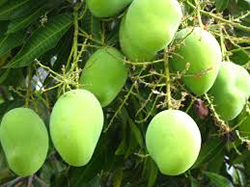 The Mango Tree is also highly desirable, with the obvious reason for its fruit. An old, Victorian era Ceylon cook book I have has a recipe for Chicken & Mango Curry, and it states: “Cooking Mangos in a curry is not the best way to eat a mango. The best way is naked, in the bath, with your lover”. The most delicious Sri Lankan Mangos come from Jaffna, and are seasonal. I have a couple of mature trees, and have additionally planted Mango trees propagated from seeds I bought in from Vietnam, whose fruit are superior. They should be productive in about four years. But the best variety of Mango anywhere is the Alphonso Mango, from India. They are in the markets each May, and I shall smuggle some in from Bombay and see if I can propagate them here.
The Mango Tree is also highly desirable, with the obvious reason for its fruit. An old, Victorian era Ceylon cook book I have has a recipe for Chicken & Mango Curry, and it states: “Cooking Mangos in a curry is not the best way to eat a mango. The best way is naked, in the bath, with your lover”. The most delicious Sri Lankan Mangos come from Jaffna, and are seasonal. I have a couple of mature trees, and have additionally planted Mango trees propagated from seeds I bought in from Vietnam, whose fruit are superior. They should be productive in about four years. But the best variety of Mango anywhere is the Alphonso Mango, from India. They are in the markets each May, and I shall smuggle some in from Bombay and see if I can propagate them here.
Rambutan
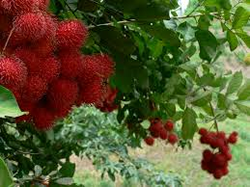 These always remind me of large, pink, hairy testicles. Similar to Lychee, they are sweet and delicious as a dessert fruit and just look great and exotoc on a fruit platter. These are recently planted, so I will need to wait about three-four years for them to produce.
These always remind me of large, pink, hairy testicles. Similar to Lychee, they are sweet and delicious as a dessert fruit and just look great and exotoc on a fruit platter. These are recently planted, so I will need to wait about three-four years for them to produce.
Pineapple
 Pineapples grow from the ground, a smallish pine with sharp serrated leaves with the Pineapple growing at its center. Being close to the ground they can attract all kinds of pests – so its usually better to rely on the local farmers for a regular supply, and Sri Lanka probaby has the best Pineapples in Asia – very large and very sweet. I keep a couple just for the fun of it but these are really a plant that needs serious looking after to make a sustainable regular crop. Nonetheless, Sri Lankan Pineapples are superb and I will get through one very other day.
Pineapples grow from the ground, a smallish pine with sharp serrated leaves with the Pineapple growing at its center. Being close to the ground they can attract all kinds of pests – so its usually better to rely on the local farmers for a regular supply, and Sri Lanka probaby has the best Pineapples in Asia – very large and very sweet. I keep a couple just for the fun of it but these are really a plant that needs serious looking after to make a sustainable regular crop. Nonetheless, Sri Lankan Pineapples are superb and I will get through one very other day.
Avocado
 Sri Lankan Avocados are superb. Huge, bright green, and very meaty, I eat at least one every day, sometimes more. My home made Guacamole is a house favorite. I have recently planted four trees and am looking forward to them reaching productivity in about three years.
Sri Lankan Avocados are superb. Huge, bright green, and very meaty, I eat at least one every day, sometimes more. My home made Guacamole is a house favorite. I have recently planted four trees and am looking forward to them reaching productivity in about three years.
Jak
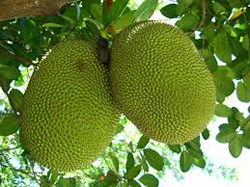 The Jak Fruit is a protected tree in Sri Lanka – it is illegal to chop them down without a permit. Accordingly, Jak wood is highly in demand as a timber as it makes beautiful, and expensive furniture. It also produces the enormous Jak Fruit – which can be cooked as a curry, or made into desserts, while the seeds are eaten as a snack. I have eight mature Jak trees, and again the excess fruit are sold onto the local markets.
The Jak Fruit is a protected tree in Sri Lanka – it is illegal to chop them down without a permit. Accordingly, Jak wood is highly in demand as a timber as it makes beautiful, and expensive furniture. It also produces the enormous Jak Fruit – which can be cooked as a curry, or made into desserts, while the seeds are eaten as a snack. I have eight mature Jak trees, and again the excess fruit are sold onto the local markets.
Olive
 Somewhere about 250 years ago, Olive trees were introduced to Sri Lanka, probably by the Portugese. They are very slow growing, and take decades to reach maturity. I have two, and they are highly productive, producing large, thumb size, meaty olives that are easily pickled in brine. I no longer need to buy jars of olives for my Martinis or salads. In fact I have so many my friends now receive jars as presents, and they are highly appreciated. Especially if I include a bottle of Plymouth Gin with them.
Somewhere about 250 years ago, Olive trees were introduced to Sri Lanka, probably by the Portugese. They are very slow growing, and take decades to reach maturity. I have two, and they are highly productive, producing large, thumb size, meaty olives that are easily pickled in brine. I no longer need to buy jars of olives for my Martinis or salads. In fact I have so many my friends now receive jars as presents, and they are highly appreciated. Especially if I include a bottle of Plymouth Gin with them.
Cashew
 The Cashew nut is not really a nut at all, but a weird, hard appendage that sprouts from the bottom of the Cashew Fruit. In Goa, India, the locals ferment the fruit to make a potent and highly alcoholic brew known as Feni. It is like cheap Tequlias wicked Uncle. Naturally, the best is home brewed, and I shall experiment. The nuts however are a Sri Lankan staple – devilled Cashews being a particular favorite.
The Cashew nut is not really a nut at all, but a weird, hard appendage that sprouts from the bottom of the Cashew Fruit. In Goa, India, the locals ferment the fruit to make a potent and highly alcoholic brew known as Feni. It is like cheap Tequlias wicked Uncle. Naturally, the best is home brewed, and I shall experiment. The nuts however are a Sri Lankan staple – devilled Cashews being a particular favorite.
Tamarind
 This tree produces large, dark pod like fruits that are full of a matted, sticky and sweet sour substance. That is boiled, sweetened, and sold as an ingredient in many curries and even desserts. Tamarind is also an ingredient in Worcester Sauce, and makes an excellent Oriental addition to sauces for meat dishes.
This tree produces large, dark pod like fruits that are full of a matted, sticky and sweet sour substance. That is boiled, sweetened, and sold as an ingredient in many curries and even desserts. Tamarind is also an ingredient in Worcester Sauce, and makes an excellent Oriental addition to sauces for meat dishes.
Clove
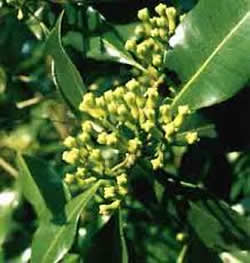 Everyone knows the dark, dried and highly aromatic cloves, fewer have seen the actual tree. I have six, mature, and producing those small tiny buds on a frequent basis. They are easy to dry and store, and I probably again have enough to sell the excess onto the local market once I start to harvest them properly.
Everyone knows the dark, dried and highly aromatic cloves, fewer have seen the actual tree. I have six, mature, and producing those small tiny buds on a frequent basis. They are easy to dry and store, and I probably again have enough to sell the excess onto the local market once I start to harvest them properly.
Cinnamon
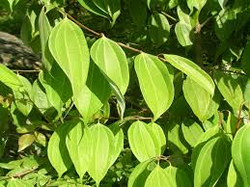 The best cinnamon in the world comes from Sri Lanka. A smallish, shade preferring tree, it is the bark of small branches that peeled (first scraping off the thin green outer layer) off the stem, dried and then used as a spice in a huge variety of ways. I planted three trees behind my garage and they are now productive. The leaves can also be used to flavor dishes – fresh tuna wrapped in cinnamon leaves and then grilled is very good.
The best cinnamon in the world comes from Sri Lanka. A smallish, shade preferring tree, it is the bark of small branches that peeled (first scraping off the thin green outer layer) off the stem, dried and then used as a spice in a huge variety of ways. I planted three trees behind my garage and they are now productive. The leaves can also be used to flavor dishes – fresh tuna wrapped in cinnamon leaves and then grilled is very good.
Wood Apple
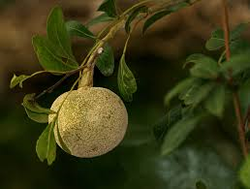 Probably unknown to many readers, the Wood Apple is self descriptive – the fruit looks exactly like an apple, but it is a hard as a cricket ball. Smash them open however, and a sour-sweet matted substance emerges, not unlike a Tamarind. The locals mix them with Coconut water to make a delicious and nourishing drink, which I often have as a breakfast juice. It also goes very well with Dark Rum in a cocktail. I have three mature WoodApples lining the driveway to one of my houses.
Probably unknown to many readers, the Wood Apple is self descriptive – the fruit looks exactly like an apple, but it is a hard as a cricket ball. Smash them open however, and a sour-sweet matted substance emerges, not unlike a Tamarind. The locals mix them with Coconut water to make a delicious and nourishing drink, which I often have as a breakfast juice. It also goes very well with Dark Rum in a cocktail. I have three mature WoodApples lining the driveway to one of my houses.
Soursop
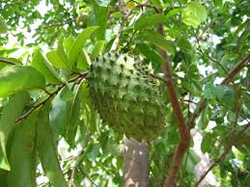 A visual cross between a small green durian and a pineapple, the curious looking Soursop produces a tart, white, citrusy meat that can be made into an excellent juice or sorbet.
A visual cross between a small green durian and a pineapple, the curious looking Soursop produces a tart, white, citrusy meat that can be made into an excellent juice or sorbet.
As can be seen, I have a multitude of productive plants – and these are mainly just the fruits. I could, if I chose, be totally self sufficent for fruit in Sri Lanka, and have enough excess to buy others. Sri Lanka is blessed with fruit, and common purchases in the market include Pomegranite, Custard Apple, Strawberries, Cherries and numerous other varieties – some of which remain unfamilar. My two acres are highly productive and as I learn more about what I have, the more I start to learn about how best to harvest and prepare them. It is a welcome change from simply purchasing everything from a supermarket.